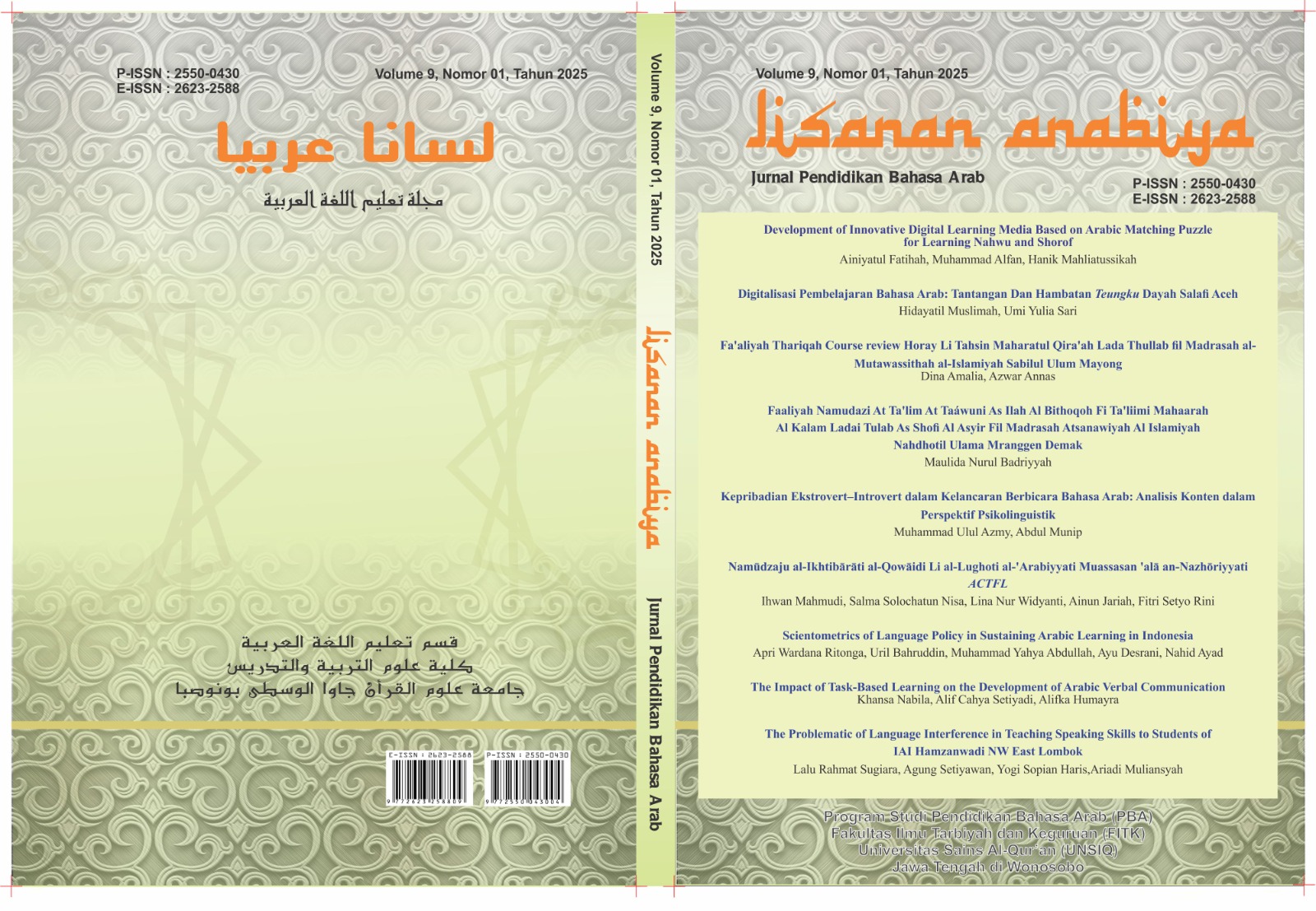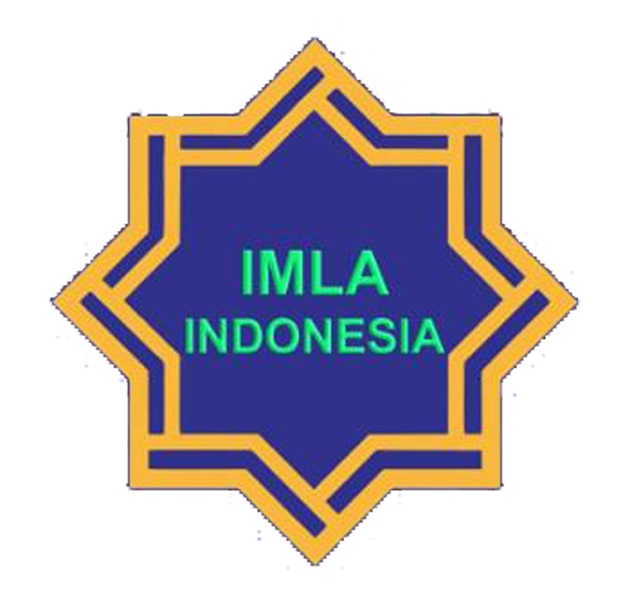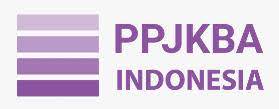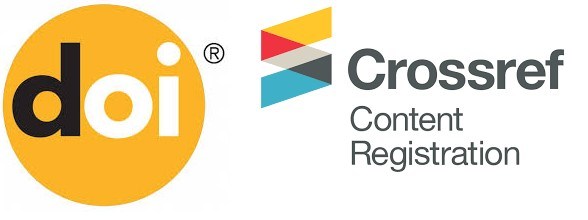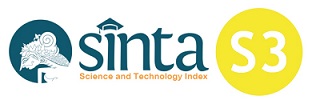Namūdzaju al-Ikhtibārāti al-Qowāidi Li al-Lughoti al-‘Arabiyyati Muassasan ‘alā an-Nazhōriyyati ACTFL
Abstract
Abstract
This study aims to develop a arabic grammar test model based on the American Council on the Teaching of Foreign Languages (ACTFL) theory. ACTFL theory emphasises the importance of communicative skills in language learning, including grammar as a fundamental component in language ability. In this study, Arabic grammar test was designed to measure grammar competence in the context of authentic and communicative language use. The research method involved library research. The results show that the developed test model is in accordance with ACTFL standards, effective in evaluating Arabic grammar competence, and can be used as a valid and reliable measurement tool in Arabic language learning. This test model is expected to help educators in assessing students' grammar skills more comprehensively and accurately, as well as supporting the improvement of the quality of Arabic language learning at various levels of education.
Downloads
References
Anisnaini, E. (2021). Upaya Meningkatkan Pemahaman Qawaid Melalui Penggunaan Media Kartu Bagi Siswa Kelas VII MTsN 8 Kediri. Edudeena : Journal of Islamic Religious Education, 5(2), 111–124. https://doi.org/10.30762/ed.v5i2.3925
Baidan, N., & Aziz, E. (2016). Metodologi Khusus Penelitian Tafsir. Pustaka Pelajar.
Fahri, A. (2009). Implikasi Penguasaan Nahwu-Shorof Siswa Terhadap pemahaman Bahasa Arab di Madrasah Tsanawiya Negeri Yogyakarta I. UIN Sunan Kalijaga.
Fauzan, M., & Faidah, U. (2021). الخطوات في صياغة اختبار اللغة العربية. Konferensi Nasional Bahasa Arab (KONASBARA) VII, 124–131.
Hadhoud, R. M. (2022). Evaluating the effectiveness of the response - after MCQ exam item analysis on students’ performance in a Communication Skills exam. Educational Research and Innovation Journal, 2(5), 1–12. https://doi.org/10.21608/erji.2022.228289
Hardan. (2020). Metode Penelitian Kualitatif dan Kuantitatif. Pustaka Ilmu Yogyakarta.
Hasanah, M., Mubaligh, A., Sari, R. R., Syarofah, A., & Prasetyo, A. (2021). Arabic Performance Curricullum Development: Reconstruction Based on Actfl and Douglas Brown Perspective. Ijaz Arabi Journal of Arabic Learning, 4(3), 779–801. https://doi.org/10.18860/ijazarabi.v4i3.11900
Herdah, Firmansyah, & Ali Rahman. (2020). Pendekatan Tes Diskret dalam Pembelajaran Bahasa Arab. AL-ISHLAH: Jurnal Pendidikan Islam, 18(1), 65–84. https://doi.org/10.35905/alishlah.v18i1.1258
Hidayah, F. H. (2019). Actfl معيار جودة تعليم اللغة العربية في المدرسة الثانوية في أندونيسيا على أسس معيار. Al Mi’yar: Jurnal Ilmiah Pembelajaran Bahasa Arab Dan Kebahasaaraban, 2(2), 127. https://doi.org/10.35931/am.v2i2.121
Ishak, Baego, & Syamsuduha. (2011). Evaluasi Pendidikan. Alaudin Press.
Jamil, H., & Agung, N. (2022). Tantangan Pembelajaran Bahasa Arab Di Era Society 5.0: Analisis Pembelajaran Bahasa Arab Berbasis Aplikasi Interaktif. Alibbaa’: Jurnal Pendidikan Bahasa Arab, 3(1), 38–51. https://doi.org/10.19105/ajpba.v3i1.5536
Labib, A., & Antika, D. H. W. (2022). Pengembangan Instrumen Penilaian Qawaid dalam Pembelajaran Bahasa Arab. JPIn: Jurnal Pendidik Indonesia, 05(02), 1–18. https://intancendekia.org/jurnal/index.php/JPIn/article/view/388
Mahmudi, I., & Badriya, I. (2023). Namūżaju Ikhtibārāt al-Lugah li al-Tarjamah al-‘Arabiyyah ‘alā Asāsi Nażariyyati Jean Piaget. Aphorisme: Journal of Arabic Language, Literature, and Education, 4(2), 100–111. https://doi.org/10.37680/aphorisme.v4i2.3965
Mahmudi, I., Yasin, A., Choliq, M., & Maghfiroh, A. (2021). أنواع اختبار القواعد في تعليم اللغة العربية. Prosiding Konferensi Nasional Bahasa Arab VII.
N. Hula, I. R., Paputungan, M. Z., & Ana Mariana. (2021). Pengembangan Hybrid Learning Berbasis Aplikasi Computer Assited Test (Cat) Pada Program Arabic Proficiency Test. Tadbir: Jurnal Manajemen Pendidikan Islam, 9(1), 103–125. https://doi.org/10.30603/tjmpi.v9i1.2063
Nisa, V. C. (2023). Pembelajaran Istima’ pada Aplikasi Arab Fun Easy Learn (Studi Analisis Konten Menurut Standar ACTFL). AN NAJAH: Jurnal Pendidikan Islam Dan Serial Agama, 02(04), 2–6.
Noverma, R. (2024). Standardization Of Arabic Languange Test Questions For Class XII MAN Pekanbaru Based On The Perspective Of ACTFL. Elmaktabah, 1(1), 56–68.
Rahmi Nur Fauziah, I., Syihabudin, S., & Sopian, A. (2020). Analisis Kualitas Tes Bahasa Arab Berbasis Higher Order Thinking Skill (Hots). لسـانـنـا (LISANUNA): Jurnal Ilmu Bahasa Arab Dan Pembelajarannya, 10(1), 45. https://doi.org/10.22373/ls.v10i1.7805
Rizal, M., Syihabuddin, & Mad’li. (2021). Evaluasi Pembelajaran Bhasa Arab dengan Memanfaatkan Aplikasi MiSK. Tsaqofiya, 3(2), 199–213.
Siregar, H. H., Moh. Ainin, Muassomah, Dadang Firdaus, & Rendi Pramadi. (2022). Exploring of Arabic Text Book for MA KMA 183 in 2019 Based on Mackey’s Theory and ACTFL Standards. Al Mahāra: Jurnal Pendidikan Bahasa Arab, 8(1), 123–152. https://doi.org/10.14421/almahara.2022.081-06
Sugiyono. (2017). Metode Penelitian Kuantitatif, Kualitatif dan R&D. Alfabeta.
Susanty, F. D. (2016). Analisis Validasi Soal Tes Hasil Belajar Pada Pelaksanaan Pembelajaran Bahasa Arab di Pusat Pengembangan Bahasa (P3B) UIN SUSKA Riau. Kutubkhanah, 19(2), 112–132. https://ejournal.uin-suska.ac.id/index.php/Kutubkhanah/article/view/2546
Taqiyah, S. Z. (2023). Implementasi Manual Media Kaana Puzzle Dalam Pembelajaran Tata Bahasa Arab. Tatsqifiy: Jurnal Pendidikan Bahasa Arab, 4(1), 34–51. https://doi.org/10.30997/tjpba.v4i1.6952
Taufik, T., Azmi, D. I., Zahire, I. N. A., Sa’adah, N., Ernawati, N., & Wulandari, P. (2023). Pembelajaran Unsur-Unsur Bahasa Arab (Mufradat dan Qawaid) dengan Penerapan Strategi Pembelajaran Flashcard di Kelas V Madrasah Ibtidaiyah (MI). Diwan: Jurnal Bahasa Dan Sastra Arab, 15(1), 58–73. https://doi.org/10.15548/diwan.v15i1.1090
Wahyono, I. (2019). Strategi Kiai Dalam Mensukseskan Pembelajaran Nahwu Dan Shorof Di Pondok Pesantren Al-Bidayah Tegalbesar Kaliwates Jember. Tarbiyatuna : Kajian Pendidikan Islam, 3(2), 106. https://doi.org/10.29062/tarbiyatuna.v3i2.262
وحي, ف., & مارية, ا. ن. (2018). تعليم قواعد اللغة العربية بقسم الأدب العربي بجامعة مالانج الحكومية. Seminar Nasional Bahasa Arab Mahasiswa II, 2, 458–467.

This work is licensed under a Creative Commons Attribution-ShareAlike 4.0 International License.
Authors who publish with this journal agree to the following terms:
a. Authors retain copyright and grant the journal right of first publication with the work simultaneously licensed under a Creative Commons Attribution-ShareAlike 4.0 International License. that allows others to share the work with an acknowledgement of the work's authorship and initial publication in this journal.
b. Authors are able to enter into separate, additional contractual arrangements for the non-exclusive distribution of the journal's published version of the work (e.g., post it to an institutional repository or publish it in a book), with an acknowledgement of its initial publication in this journal.
c. Authors are permitted and encouraged to post their work online (e.g., in institutional repositories or on their website) prior to and during the submission process, as it can lead to productive exchanges, as well as earlier and greater citation of published work (See The Effect of Open Access).

